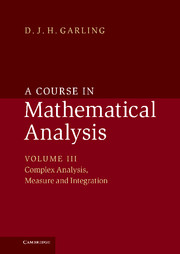Introduction
Published online by Cambridge University Press: 05 June 2014
Summary
This book is the third and final volume of a full and detailed course in the elements of real and complex analysis that mathematical undergraduates may expect to meet. Indeed, I have based it on those parts of analysis that undergraduates at Cambridge University meet, or used to meet, in their first two years. I have however found it desirable to go rather further in certain places, in order to give a rounded account of the material.
In Part Five, we develop the theory of functions of a complex variable. To begin with, we consider holomorphic functions (functions which are complex-differentiable) and analytic functions (functions which can be defined by power series), and the results seem similar to those of real case. Things change when path-integrals are introduced. To use these, a good understanding of the topology of the plane is needed. We give a careful account of this, including a proof of the Jordan curve theorem (every simple closed curve has an inside and an outside). With this in place, various forms of Cauchy's theorem and Cauchy's integral formula are proved. These lead on to many magical results. Chapter 25 is geometric. A single-valued holomorphic function is conformal (that is, it preserves angles and orientations).
- Type
- Chapter
- Information
- A Course in Mathematical Analysis , pp. ix - xPublisher: Cambridge University PressPrint publication year: 2014



